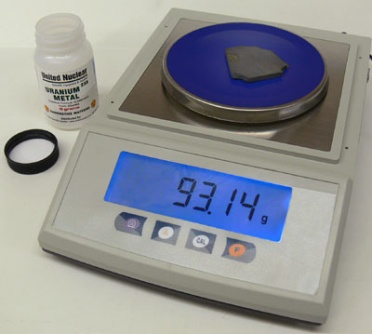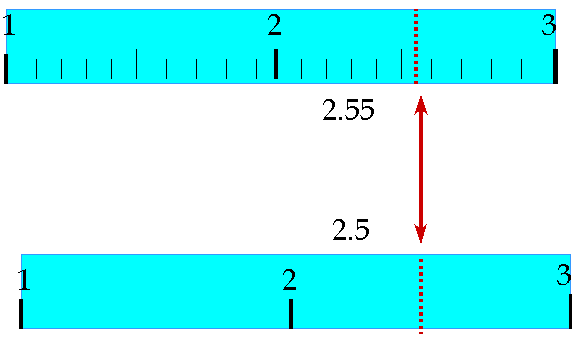BIOL 1406
PreLab 1.6
When reporting a
measurement, how many significant digits should I use?
 |
When making measurements, you must report your results
using the correct number of significant digits (also called significant
figures.) The significance of a digit has to do with whether or not it
represents a true measurement. Any digit that can be accurately measured or
reasonably estimated with the particular measuring device you are using is
considered significant. It is easy to
determine the number of significant digits when using a digital measuring
device; simply assume that all digits shown on the display are significant.
For example, if you are weighing an object on an electronic balance and the
display shows 93.14 g, record all of the digits and assume that the balance can
accurately estimate the weight to the nearest one-hundredth of a gram. In
this case there are 4 significant digits. |
|
Balance reading with 4 significant digits |
| When using an
analog
measuring device, the decision is a
little more complicated. In this case, the first estimated digit should
be the last significant digit reported in the measured value. For example if
you are measuring temperature with a thermometer where the smallest calibration
marks are 10 degrees apart, then the first estimated digit would be the
nearest whole degree and that would be the last significant digit reported
in your value. Such a thermometer could be used to report a
temperature of 47
oC but not 47.0 oC or 47.00 oC. On the other hand,
if the smallest calibration marks on the thermometer are one degree apart, then
the first estimated digit would be tenths of a degree and that should be
the last significant digit reported in your value. Such a thermometer could be
used to report a temperature of 47.0 oC but not 47 oC or
47.00 oC.
Look at the thermometer on the right, notice that the marks are in 10
degree increments. On this device, the most accurate measurement would be
plus or minus 1 degree. Therefore, the value should be read as 35
oC, not 35.0
oC. |
 |
|
Thermometer |

 Notice that on the top scale, we can approximate the distance more accurately,
i.e. 3 significant digits, compared to the same distance measured using the
bottom scale, i.e. 2 significant digits.
Notice that on the top scale, we can approximate the distance more accurately,
i.e. 3 significant digits, compared to the same distance measured using the
bottom scale, i.e. 2 significant digits.
How do I determine
the number of significant digits in a reported measurement?
To determine the number of significant digits in a reported
measurement, we need to look at two cases:
A. Numbers with Indicated Decimals
1.
All non-zero digits (1-9) are counted as significant.
2.
Only zeros that have non-zero digits somewhere to the LEFT of them are
considered significant Ė all other zeros are place holders
For example, in the value
0.0012010 g, only the last 2 zeros have non-zero digits to their left and
are counted as significant. The first 3 zeros are merely place holders and are
not significant digits. Therefore, the total number of significant digits in
this value is 5.
B. Numbers without Indicated Decimals
1.
All non-zero digits (1-9) are counted as significant.
2.
Zeros that have non-zero digits somewhere to the RIGHT of them are
considered significant, but there is no way of knowing whether any other zeros
are significant.
For example, in the value
100,500 g, the first 2 zeros are significant because there is a non-zero
digit to their right. However, we really donít know if the 3rd or 4th
zeros are significant. This ambiguity can be avoided by writing the number with
a decimal or by using scientific notation. When using scientific notation, all
digits before the multiplication sign are considered significant. For example,
to write 100,500 g using scientific notation:
-
If
the 3rd and 4th zeros are not significant, you could
write 100.5 x 103 g (4 significant digits)
-
If
the 3rd zero is significant but not the fourth, you could write
100.50 x 103 g (5 significant digits)
-
If
both the 3rd and 4th zeros are significant, you could
write 100.500 x 103 g (6 significant digits)
Close this browser window to return
to Blackboard and complete the practice quiz and assessment quiz.



